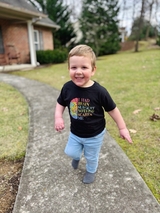Rowan’s Story: Functional Hemispherotomy Epilepsy Surgery
Rowan’s Story: Functional Hemispherotomy Epilepsy Surgery
Tanya and Brandon say the transformation their son Rowan has experienced since undergoing functional hemispherotomy surgery at CHOP has been “unbelievable.”

For the first year of his life, Rowan was a perfectly healthy baby. Then, shortly after he turned 1, his mom Tanya witnessed him doing something that gave her pause. He jerked his body, as if something had startled him out of the blue. Just a second later, he was back to being his smiley, happy self.
With two other kids ages 3 and 6 running around, it often gets loud in the family’s house. So, at first, Tanya and her husband Brandon thought noise from Rowan’s siblings must have just startled him. But by the end of the week, the jerking movement was happening every day and in clusters, and the movement had become more forceful, so they could tell it was involuntary.
Tanya spoke with the family’s pediatrician, who referred Rowan to a local neurologist in the family’s hometown of Chambersburg, Pa. The neurologist performed an electroencephalogram (EEG), which revealed Rowan was experiencing infantile spasms. This is a type of seizure disorder that begins in the first one to two years of life. It can be associated with a developmental regression (a loss of developmental milestones) and a highly irregular pattern of brain electrical activity, called hypsarrhythmia. Based on the EEG results, the neurologist estimated Rowan was having about 40 seizures a day.
The neurologist prescribed Rowan a medication that stopped the spasms for a little while, but it wasn’t long until they came back. Over the next few months, the neurologist tried a handful of different medications, but the spasms only got worse, and they soon evolved into a type of seizure called drop attacks.
“He would suddenly lose muscle tone and just fall to the floor,” says Tanya of the drop attacks. Depending on the force of the fall, Rowan often hit his head or injured another part of his body. The seizures were also starting to hold Rowan back developmentally.
“It was almost like he wasn’t there sometimes. He would just stare off and he wasn’t his best self,” says Tanya. “It was terrible. Truly heartbreaking.”
Referral to Neuroscience Center

The local neurologist referred the family to Children’s Hospital of Philadelphia (CHOP) to see if Rowan qualified for surgery to stop the seizures. CHOP’s Neuroscience Center is recognized worldwide for advanced treatment options and cutting-edge surgical treatment.
In October 2023, the family drove three hours east to CHOP. They met with pediatric epileptologist France W. Fung, MD, who performed a completely new and thorough evaluation. Rowan underwent magnetic resonance imaging (MRI) and magnetoencephalography (MEG), and he was admitted to CHOP’s Epilepsy Monitoring Unit (EMU) for three days of continuous EEG monitoring.
Each room in the EMU is outfitted with state-of-the-art equipment that monitors and captures brainwave data when patients experience seizures. This information allows the clinical team to pinpoint which brain regions are part of the seizure onset zone to determine if a child is a candidate for epilepsy surgery.
When the evaluation was done, the Neuroscience Center’s large interdisciplinary team of pediatric neurologists, neurosurgeons, pediatric epileptologists, fellows and residents, among others, met to discuss the results and the best path forward for Rowan. The EEG revealed all of Rowan’s seizures were coming from his left hemisphere. This made him a candidate for a functional hemispherotomy. In this procedure, the side of the brain causing seizures is disconnected from the healthy side of the brain and the brainstem.
Benjamin Kennedy, MD, CHOP Attending Neurosurgeon and Director of Epilepsy and Functional Neurosurgery, met with Tanya and Brandon and explained what the procedure entailed and its risks and benefits. He said most patients are seizure free after surgery and maintain normal brain development. He also told them Rowan might lose some function on his right side and need to relearn some skills, like walking. The couple left the conversation feeling the utmost confidence in Dr. Kennedy and his team.
“I never doubted that [Rowan] was in the best care,” says Tanya. “I can’t say what that means to me. It was a really scary situation, and they made it a little bit easier for us.”
No seizures since functional hemispherotomy
In February 2024, the family relocated to Philadelphia for the hemispherotomy procedure and Rowan’s postsurgical recovery at CHOP. It was a long month away from home, but it was worth every minute. Rowan hasn’t had a single seizure since.
“I would take it a thousand times over knowing now that he’s seizure-free,” says Tanya. “We will forever be grateful for their care,” she says of Dr. Kennedy and his team. “They’ve changed my son’s life!”
Today, Rowan, age 2, can talk, walk, run and “do everything a 2-year-old should,” says his mom. Although hemispherotomy results in loss of peripheral vision on one side, he has grown accustomed to this, is working to regain function of his right hand, and has taken off cognitively.
“He is thriving,” says Tanya. “He’s getting into everything, and I welcome it. I’m just so thankful that he has the chance to succeed.”
Rowan has regular follow-up appointments with his local neurologist and will return to CHOP once a year for an evaluation. Dr. Kennedy is hopeful he’ll never have another seizure again.
“When we think about where we were a year ago and where we are now, it’s just unbelievable,” says Tanya. “A huge weight has been lifted.”